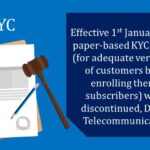The Department of Telecommunications has notified the National Digital Communications Policy -2018 – (Policy), effective 22nd October,2018.
The objective of this Policy is to prepare the country and its citizens for the future. Achieving these goals would require that the key stakeholders – namely the Centre, the States, local governments and agencies, Telecom Service Providers, Internet Service Providers, handset and equipment manufacturers, the academic community, the innovators and start-ups come together to forge a coalition to deliver this national policy and its missions.
The Policy aims to accomplish the following Strategic Objectives by 2022:
- Provisioning of Broadband for All
- Creating 4 Million additional jobs in Digital Communication Sector.
- Enhancing the contribution of the Digital Communications Sector to 8% of India’s GDP from 6% in 2017.
- Propelling India to the Top 50 Nations in the ICT Development Index of ITU from 134 in 2017.
- Enhancing India’s contribution to Global Value Chains, Ensuring Digital Sovereignty.
Key highlights of the Policy:
- Enabling Infrastructure Convergence of IT, telecom and broadcasting sectors:
- Amending the Indian Telegraph Act, 1885 and other relevant acts for the purpose of convergence in coordination with respective ministries.
- Establishing a unified policy framework and spectrum management regime for broadcast and broadband technologies
- Restructuring of legal, licensing and regulatory frameworks for reaping the benefits of convergence.
2. Develop an ecosystem for satellite communications in India, with focus on:
- Streamlining administrative processes for assignment and allocations, clearances and permissions related to satellite communication systems.
- Promoting local manufacturing and development of satellite communications related infrastructure through appropriate policies.
- Promoting participation of private players, with due regard to national security and sovereignty.
- Incentivizing the use of renewable energy technologies in the communications sector, including:
- Encouraging the utilization of small cell fuel batteries, lithium-ion batteries or other similar technologies to improve energy consumption efficiencies
- Promoting research and development of green telecom through active participation of stakeholders across government, industry and academia
- Rationalizing of taxes and levies on the manufacture, production and import of such equipment for digital communication technologies
3. Reforming the licensing and regulatory regime to catalyze Investments and Innovation, and promote Ease of Doing Business by:
- Reviewing levies and fees including License Fee, Universal Service obligation Fund (USOF) levy and concept of pass through revenues in line with principles of input line credit.
- Rationalizing Spectrum Usage Charges (SUCs) to reflect the costs of regulation and administration of spectrum.
- Rationalizing taxes and levies on Digital Communications equipment, infrastructure and services.
4. Simplifying and facilitating Compliance Obligations by:
Promoting Start-ups.
- Local Manufacturing and Value Addition.
Source: Department of Telecommunications, Government of India




